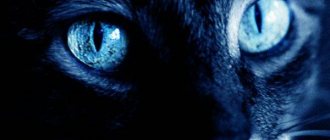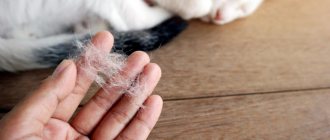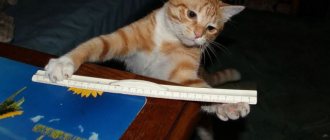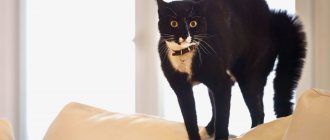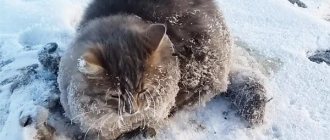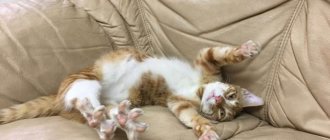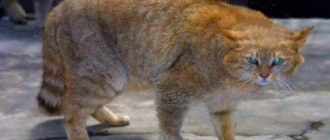Can cats see reflections in mirrors?
Of course, they do have eyes. And what do they see there?
We cannot say what exactly the mirror shows our pets. We can only interpret their reactions. But it seems that the cat sees in the mirror... another cat.
Some see their reflection as a potential friend, especially kittens who are excited to play with their new friend.
Others find a hostile stranger in the mirror. And let the battle begin!
Thank you for watching!
If you liked the video, share it with your friends:
But! But most cats are indifferent to mirrors
I wonder why many cats completely ignore mirrors? Low intelligence? No way!
Don't underestimate a cat's intelligence. Someone joked: If a cat does something, we call it instinct. If we do the same, we call it intelligence
It's important to understand that a cat's brain works differently.
How does a cat's brain work?
Cats seeing their reflection in the mirror interpret it as another animal encroaching on their territory. Therefore, pugnacious warriors, ready to defend their refuge, immediately arch their backs and wave their paws in a funny way. Kittens, on the contrary, perceive the reflection as a friend with whom they can fool around and frolic.
Research has shown that most four-legged pets are not at all interested in the image that appears in the mirror surface. Common people explain this calm behavior by differences in intelligence, supposedly some animals are smart and others are not. In fact, the cat’s brain is designed in such a way that everything it does is an instinct dictated by nature.
Why?
Vision for cats, unlike people, monkeys and other animals, is not the main organ for receiving information.
Cats live in a world of sounds, smells and other sensations, some of which are inaccessible to us.
After all, among other things, nature has provided the cat with additional sensors. These are vibrissae - hard tactile hairs that are several times longer and thicker than ordinary hair.
In addition to the whiskers located above the upper lip, there are also whiskers on the cheeks, on the chin and above the eyes, on the ankles of the front paws, on the tail and between the paw pads. Any touch to these whiskers sends information through their nerve endings to the brain, and the cat instantly reacts even to minor changes in the environment and fluctuations in air currents. And after that, you want her to be interested in some flat image that doesn’t make sounds, doesn’t smell, doesn’t produce tactile changes in the surrounding space?!
Even having initially shown interest in the “mirror animal” (this is especially typical for inexperienced kittens), in the absence of “feedback” the cat quickly loses it, retaining the experience gained.
Thus, the cat is simply “above” to waste time on a dummy reflection. Well, a cat considers it generally inappropriate to simply look at its appearance, because it is perfection itself.
In general, a serious test of the intelligence and consciousness of animals is the so-called
How to train a cat to look in the mirror
If you wish, you can teach your cat to recognize itself in the reflection. To do this you need the following:
- taking the cat in your arms, stand in front of the mirror - the animal will definitely recognize the owner in the reflection;
- without leaving the mirror, stroke the cat so that it sees that the movement of the person’s hand and the reflection coincide;
- give the cat a treat in front of the mirror so that he sees that the reflection is eating the same thing.
Cats are unusual creatures that require confirmation of the existence of an object by smell or sound. That which cannot declare its existence to them usually does not receive the interest of a domestic predator. This is the answer to the question why the cat does not look in the mirror. Most pets do not allow into their world what cannot be felt and do not look at reflections.
If a cat is not blind, then it still sees its reflection, but it’s another matter that it does not recognize itself. Why? To put it simply: the cerebral cortex, also known as the pallium, also known as the cortex, is responsible for making further decisions in the brain. It is easy to guess that the more complex the brain is, the more complex the processes in it will occur.
The “ancestor” of the BP cortex, the paleocortex, appeared in fish. In amphibians, the paleo-passed into the archicortex (primary medullary vault); in reptiles, the seeds of the mind appear in the form of embryonic formations of the neocortex (secondary MS, more developed in our country). This passed on to birds in almost the same form, but from mammals the process of development of the neocortex really advances by leaps and bounds.
Here it is worth remembering that the brain has convolutions and fissures. The fact is that the brain really wanted to grow, but the skull somehow couldn’t keep up, so the cortex, from being “shoved in”, began to bend inward as it developed intensively. This does not give us the right to assert that the more crowded the brain, the smarter the animal (in dolphins, for example, it is very walnut-like), but it is possible to trace some patterns specifically about the complexity of the structure and the ability to analyze.
The simplest solution for the cortex is to bend in half, in almost all mammals we observe the Sylvian fissure (screen of Zelenevsoky’s textbook, number 3, dog brain), number 10 is the Sylvian gyrus, it is surrounded by three lateral arcuate gyri. These convolutions are clearly visible in dogs (and look at cats here), while in horses or cattle/meat cattle they are poorly distinguishable. From species to species, a bunch of all sorts of furrows and convolutions appear, they are expressed to varying degrees, but I don’t want to overload the already long answer.
What about the primate brain? Greater primates have a more complex pattern of grooves than the same cat, the pattern is outrageously similar to a human one, there are practically no significant differences, referring to the data of a study from 1936 (we are still talking about anatomy, 80 years is not critical here, don’t rush it). They have the ability for secondary cortical analysis, that is, they recognize and associate objects.
It is interesting that in lemurs (lower primates) the cortex went the opposite way - its surface area increased not due to bends and grooves, but due to the hemispheres growing in volume. Therefore, their brain is large relative to the carcass, but almost smooth. The conclusion is the same as in the first paragraph: in cats, the brain is not designed to analyze so remotely, the ability to draw a conclusion is not developed (a conditioned reflex is another thing).
Thank you for the question, it made me go back to the anatomy textbook and gave me the kick to start studying neurology again. Offtopic: I remember Dovlatov’s “And these fools will write everything in three hours,” it would be interesting to read the reasoning of intellectualists, neuroscientists, etc.
Dogs won't recognize either. More precisely, this is a question not only about recognizing oneself. but about the fact that these creatures often cannot distinguish an imitation image from the original. The dog will try to get an image, for example, bones from the iPad monitor. many primates who are hooked on advertising and other videos can also behave this way as a result.) When the flow of images is very large, then the complex mechanism of the human brain may experience a malfunction.
Answer
2 more comments
But what do cats see? They may not recognize themselves, but do they just see a conventional cat? Why aren’t they interested in this abstract cat, don’t look at it, don’t try to contact it? Even if they cannot identify their reflection as also a cat, they don’t seem to see any creature or just an interesting object in the reflection? Although, for example, my cat sees me in the mirror, can look into my eyes and respond with a meow while still looking at my reflection.
There are many psychologists in the world who are trying to understand the mysteries of the human psyche and cannot. But man is such a creature that everything is not enough for him, he wants to explain everything in the world. Even why the cat looks in the mirror.
We suggest you read: How to remove fur from a cat’s stomach at home
Cats don't recognize themselves in the mirror. The image may frighten them because they cannot smell anything. If your cat starts yelling when looking in the mirror, it is better to hide it away. You never know what she saw there. The mystery of mirrors is not yet fully understood by people; sometimes they reflect something that cannot be seen in the real world.
This is one of the superstitions. All prejudices can only harm those who believe in them. It is believed that the mirror is a portal to the other world, from where the souls of dead people and other entities can come to us. If a cat looks in the mirror, an evil entity may enter it and the animal will become ill or become aggressive.
Another prejudice that is harmful only to those who believe in it. It is believed that if a mirror is broken in a house, the owners will not see happiness and prosperity for seven years. It doesn’t matter who broke it – a person or a cat.
Cats love to play and show off in front of their owners. They love to be the center of attention. They will often lie on their backs, raise their paws and roll around on the floor, showing everyone: “Look how beautiful, soft, fluffy little paw I am!”
This is how cats may ask for a treat or show a desire to play with their owner. Each animal has its own intentions, which are easy for a caring owner to understand. Maybe the cat wants its owner to caress it, stroke it, or just scratch its back.
The cat rolls around in the dust because his owner doesn’t like to clean the apartment. Rolling on a clean floor is, of course, more pleasant. Then the cat will have to lick the dust, sneeze and cough. And the owner will treat him for allergies by buying hypoallergenic Royal Canin.
A cat can roll on the floor if fleas bite him, then he doesn’t care where - in the dust or on the carpet, just to relieve the itching from the skin a little. Maybe the cat is just playing with his favorite toy that rolled under the dusty sofa. If the cat is not neutered and is on a spree, he will not only roll around in the dust, but will begin to mark corners and scream heart-rendingly.
Perhaps the largest number of prejudices, omens, superstitions, legends, beliefs, myths, witchcraft rites and mystical rituals are associated with pets. And most of them are very unfair to graceful beauties. For example, cruelty to black cats or the mystical connection of an animal with a mirror. By the way, there is still no clear answer as to why you shouldn’t show your cat a mirror.
These affectionate pets have been with humans for more than ten millennia. Almost all over the world, these mysterious animals were worshiped, considering them sacred, bringing good luck and happiness, God's message. The unfortunate exception were the black representatives of the cat family, who at a certain point in history were considered the devil's spawn, an indispensable attribute of witches' Sabbaths, mystical rites, and satanic rituals.
Mirror test
For many years, scientists believed that only humans and apes could recognize themselves in the mirror.
In 1970, American zoologist Gordon Gallup monitored the behavior of primates in front of a mirror. It turned out that great apes - chimpanzees, gorillas and orangutans recognize themselves in the mirror. At first they perceive their reflection as another animal, but after a while they begin to search the fur, guided by what they see in the mirror.
Gallup conducted a simple experiment: euthanized animals had their brow ridges and ear tips painted with odorless paint. When they woke up, they did not notice these changes. But, looking at themselves in the mirror, they began to actively touch their eyebrows and ears. Without a doubt, the primates understood that they saw themselves in the mirror - they realized that they looked different than before.
The mirror test revealed five species of animals that associate themselves with their reflection. These are orangutans, gorillas, chimpanzees, dolphins, elephants. Also, of course, humans (starting from about 18 months of age) and... European magpies.
An interesting fact is that some animals (for example, pigs), ignoring their own reflection, are able to understand and use other information seen in the mirror, for example, they perceive the mirror projection of food placed behind them.
Cats are not included in this “Smartest” club.
So what does this mean? Why are they stupid? What do they lose in intelligence to magpies?! Oh no!
A lack of interest in their reflection is not necessarily a sign that they are not self-aware.
The point is the survival characteristics of a particular species. While primates rely on vision, cats prioritize smells and other tactile sensations.
How a cat reacts to a mirror depends on its age, experience and intellectual potential.
Kittens are always ready to play, even with their own reflection. But they soon discover that the mirror kitten does not give any feedback. As a result, they usually abandon an uninteresting toy that does not respond to their reproduction of the prey drive. And when a reflection fails the "sniff" test, the animal usually decides to ignore it forever.
Aggressive reaction of cats to mirror reflections
According to zoologists, cats do not realize and do not understand at all that it is they who are displayed in the mirror, therefore, in addition to indifference, they can also show signs of aggression. Very often, when they see their reflection, they mistake it for another animal. And the other individual is a rival who must be driven out of his territory.
That is why you can very often observe how a cat, at the sight of its reflection, arches its back, hisses and in every possible way tries to scare and drive away its mirror “enemy”. Usually the animal makes such an attack attempt only once. Later, the cat realizes that this rival is only imaginary and does not pose any threat to it.
The following technique will help prevent aggression and help the cat recognize itself in the mirror. You need to take your pet in your arms and approach a large mirror with him. She will definitely recognize the reflection of her master in him. In this case, the cat needs to be stroked and scratched so that it can see it in the mirror. Most pets easily connect these two events and never show signs of aggression or fear again.
How cats see people
From time immemorial, cats have lived next to humans. There is a belief that this animal is a guide to the other world. The cat's gaze has given rise to many mystical speculations among the population of different countries. Indeed, cats see the world differently than humans, and they are able not only to see, but also to feel the owner himself.
Well-known fact: “A cat can see perfectly in complete darkness.” For a long time, scientists have been trying to figure out the reason why cats, unlike people, see in pitch darkness.
According to the results of the study, this feature in cats lies in the special anatomical structure of their eyes. So, in the dark, the pupils of cats dilate (also happens in the process of hunting or excitement), and in order to focus on a specific object, the pupils of the animal narrow.
In addition, the vertical structure of the pupil allows cats to protect their eyes during the day from sunlight and ultraviolet radiation.
But cats' eyesight is not perfect. The animal sees poorly during the day, compared to a human. Bright light is unpleasant for cats and they are very sensitive to it. That’s why cats see everything blurry and unclear during the daytime.
Color range
Cats can hardly tell the difference between red, yellow, orange and green. Pets perceive blue, violet and blue as one color. Pets are able to distinguish other colors. At night, cats see many more shades of gray than humans.
Many people are sure that their pets are able to see the other world, which is inaccessible to the human eye. This statement was due to the abnormal behavior of cats. Thus, owners often observe how their pets seem to be peering into something invisible, and then suddenly jump up and run away, demolishing everything in their path.
We suggest you read: Food for pregnant cats
This behavior of cats can be explained simply. Almost all the changes that occur around are perceived by pets with their ears, and after looking at the picture, they are able to be startled by the slightest rustle, which leads to a similar reaction.
There is a sign that a black cat has magical powers (protection), and if you get such a pet, then trouble will never touch the owner.
It doesn’t matter whether it’s a Siamese or a Thai cat, all pets have the same abilities, the same applies to tricolor cats.
It is also known that cats perceive ultrasounds that humans cannot perceive. The animal perceives light waves faster than humans, but whether cats see the souls of the dead or the biofield remains a mystery.
The energy of cats is calming for humans. By placing a furry pet in his arms, the owner can bring his emotional state back to normal. You need to stroke your cat with a positive attitude and fur.
Negative human energy is felt by cats; they can hiss and scratch.
Cats and kittens can see at a distance of up to 800 meters. Mustaches see well from 1 to 60 meters, but closer to this distance they see objects unclearly. Sometimes you can notice that a cat walks without noticing objects that are found nearby.
If you bring a cat to a mirror, it behaves somewhat inappropriately - it begins to hiss, flatten its ears, scratch, and fight with itself. In fact, pets see themselves in the mirror, but they do not understand that they are in the reflection. They are afraid that the reflection does not produce any tactile or auditory vibrations, which causes this behavior.
As for TV, zoologists say that cats only see flickering on the monitor. The moving objects on the pet screen are mesmerizing. Many owners have noticed that cats love to watch programs about animals. Scientists cannot explain this phenomenon.
How to overcome aggression towards your reflection?
The reason for the phenomenon is “inexperience” and a negative reaction to a stranger. This is how you can calm your cat down.
- Take the fluffy in your arms.
- If the animal tenses up, begins to hiss or struggle, you need to pet it and say kind words.
- Repeat the “procedure” several times.
As a result, the cat will understand that the one who is reflected is good and harmless, since he is loved by the owner, whom cats are able to recognize.
Watching your pet, you can notice many oddities that are characteristic of these animals. Cats are one of the most unpredictable and mysterious animals on earth. Therefore, a furry's unpredictable or inexplicable reaction to its reflection has many unconfirmed explanations. But there is one main nuance - cats cannot recognize themselves.
Observers
Although cats do not recognize themselves in the mirror, they can still use it for personal purposes. If a pet lies with its head towards a reflective surface, it always knows what is happening behind its back. If an animal spends enough time in a room with a mirror, it can begin to observe other family members with its help. Seeing the owner in the reflection, the cat turns to him. It is unknown whether the pet understands that there is only one person in the room. In addition, cats can use a mirror to look into inaccessible areas of the room.
Thus, the cat is not able to recognize itself in the mirror. At first, an unfamiliar object that is perceived by the animal as real can cause aggression or curiosity. But when the animal realizes that the reflection does not interact with it in any way, it will lose interest in it. However, cats can use mirrored surfaces to observe their surroundings.
Why can't you show your cat a mirror? Cats are guides to the portal of the other world
To this day, many people believe that cats have mystical powers from birth. Since ancient times, cats have helped people avoid many problems, for which they were revered, but thanks to this, the fear of animals was born.
Their independence and love for night walks have always been perceived as something special, as if the cat consciously understands where, why and for what purpose it is going. Many animal lovers suggest that, having a sensitive sense of smell and a mystical gift, a cat, by its mysterious nature, can act as an intermediary and serve as a kind of conductor connection between the consciousness of a living person and the world of the dead.
Often, with the help of a cat, a brownie establishes a connection with a person and warns of possible misfortunes.
Evil spirits will not be able to penetrate the territory where the small animal lives, because the cat not only protects the house from evil spirits, but also expels it from the premises if evil spirits have settled in the apartment before. Then the question arises: why, in fact, can’t you show your cat a mirror? Surely, by looking into it, she can see what is beyond the reach of the human eye and drive away any entities?
People, at the time the mirror appeared, believed that it had supernatural mystical abilities. The mirror world scared them. It was assumed that the reflective surface holds the souls of all the dead, who, if desired, can go out into our world and take the souls of people with them or drive those who admire them crazy by showing them pieces of their lives. Maybe entities had the ability to move into the bodies of domestic cats, and because of this, a superstition arose that a cat should not be shown a mirror?
As a refutation of this prejudice, another very interesting superstition arises. It was believed that if a relative died in the family, then the new victim would certainly be the one who was the first to look in the mirror after what happened in the house. Naturally, no one wanted a repeat of the misfortune in the house, so for preventive purposes, they first brought the pet to the mirror.
We suggest you read: Crusts on the nose in cats: causes and treatment at home
Unfounded prejudice
In fact, cats have different attitudes towards the mirror. Adult cats and kittens prefer to play with it because, according to cat lovers, they think it is a real live kitten. But after some time, interest in the looking-glass friend disappears, because there is no response, no smell, no sound from him.
Sometimes a cat's behavior in front of a mirror looks really quite strange. The pet begins to arch its back, looking not even at its mirror reflection, but somewhere deep within the surface, snorting and hitting the mirror with its paw. Sometimes a cat, ruffled, can look in the mirror for hours, reacting aggressively to any attempts by the owners to move it to another place. It looks like the cat is going crazy.
What is this connected with? Superstitious people claim that the cat is in contact with otherworldly entities, the souls of dead people. Experts who study the behavior of cats suggest that something has been rearranged in the apartment, the interior has been changed. Cats are very sensitive to things that are out of place. Cats generally love order in family relationships, in the arrangement of furniture, and in many other things.
People who have beloved animals in their homes, according to scientists, live much longer and are less susceptible to various stresses, diseases of the cardiovascular system, depression and mood swings. Stop trusting speculation, signs, what your neighbor or best friend said.
From time immemorial, people have been interested in the question of whether cats see themselves in the mirror. Previously, when science was not as developed as it is now, it was difficult to answer this question; people were content with only assumptions or superstitions. Today, any educated person has an idea about the vision of animals and their ability to contemplate certain objects.
